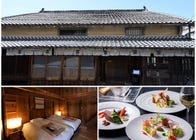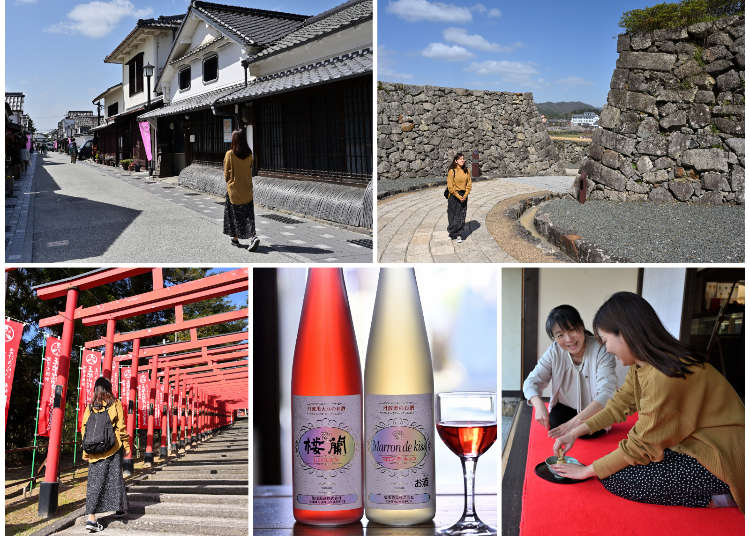
11 Things To Do in Tamba-Sasayama - Japan's Castle Town with 400 Years of History
- Written by: WESTPLAN
Tamba-Sasayama prospered as a castle town over 400 years ago with the establishment of Sasayama Castle. To this day, traditional Japanese architecture, such as wooden shops and residences, still surrounds the remnants of the castle, sending visitors back in time to the Edo Period, when samurai and merchants still walked about. Many of these old buildings have recently been renovated into trendy cafes, restaurants, inns, and shops, which have been growing in popularity amongst Japan’s youth and families.
Tamba-Sasayama is renowned for its agriculture and abundance of food products, with specialties such as black beans, chestnuts, mountain potatoes, and gibier. While autumn marks the peak tourist season, Tamba-Sasayama is a year-round destination for Japanese food and culture. Conveniently located near Osaka and Kobe, this is one suburb of Japan you’ll definitely want to visit!
Introducing the Historic Castle Town of Tamba-Sasayama
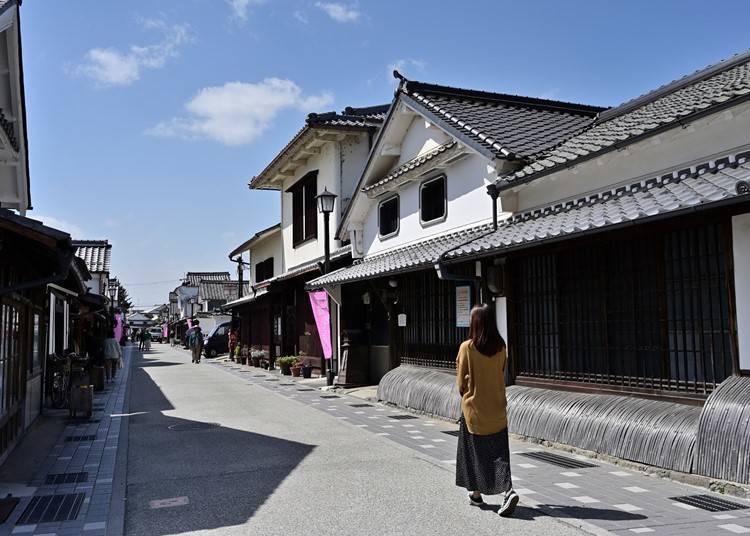
Tamba-Sasayama is located in the central-eastern part of Hyogo Prefecture, right next to Kyoto Prefecture. Historically, the area was known as the Tamba Province, which included parts of both Hyogo and Kyoto Prefectures.
Tamba thrived as an essential transportation hub connecting the capital of Kyoto with the San-in region. However, it endured significant damage during conflicts that shaped its history.
Nevertheless, peace prevailed after Sasayama Castle was built in 1609, and the samurai culture flourished. In 2015, the town was designated as the first Japan Heritage site in the country, with the story “Tambasasayama Dekansho Bushi–Hometown Memories Passed Down in Folk Songs.”
As a result, Tamba-Sasayama has gained popularity throughout Japan as a place for visitors to experience the streets and traditions depicted in the lyrics of the songs.
In 1999, the amalgamation of four towns led to the formation of Sasayama City. The city was renamed to Tamba-Sasayama City in 2019. However, if you look at older maps, you’ll still find it written as Sasayama City.
- From JR Osaka Station, take the JR Fukuchiyama Line Tambaji Rapid Service train to Sasayamaguchi Station (approx. 1 hr 10 min / 1,170 yen).
- Alternatively, you can also take the Limited Express Koutonori (approx. (53 min / 2,700 yen / includes reserved seats / fares may vary by season).
- Recommended rail pass: JR WEST All Area Pass, JR Kansai-Hiroshima Area Pass
Getting to the castle town from Sasayamaguchi Station
Sasayama Castle is about 5km from Sasayamaguchi Station. Buses, taxi stands, bike rentals, and car rentals are all available in front of the station for your convenience.
- Buses / Rental Cars: Available at Sasayamaguchi Station West Exit (Times Car Rental is a short walk away)
- Taxi Stand / Rental Bicycles: Available at Shinoyamaguchi Station East Exit (Note: the bus stop here does not go to Castle Town).
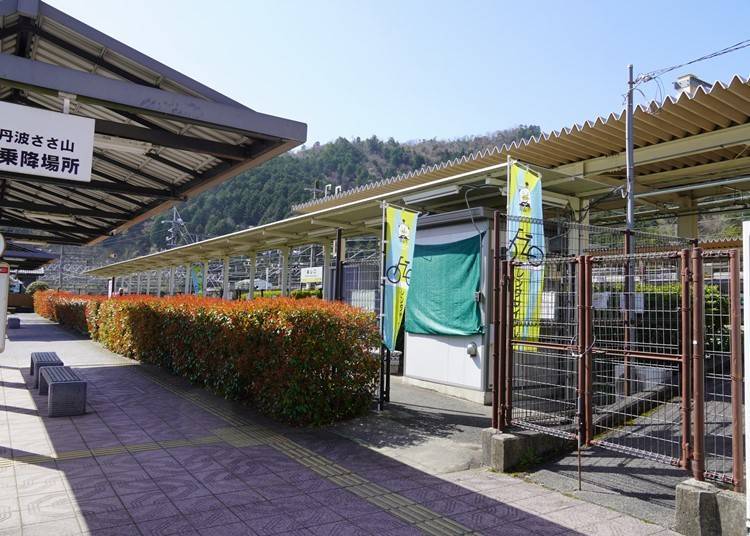
- By Bus (Wing Shinki)
- Take a bus bound for Sasayama Office from No. 2 bus stop at Sasayamaguchi Station West Exit; get off at Nikaicho. Buses run from 7:20 a.m. - 8:15 p.m. (1-2 buses per hour). Fares for adults (12 and up) and children (ages 2-6) vary by distance traveled.
- By Rental Bicycle
- JR Sasayamaguchi Station Cycle Port (JR Sasayamaguchi Station East Exit).
Located in front of the bus stop downstairs from Sasayamaguchi Station East Exit.
Hours: 9:00 a.m. - 5:00 p.m. (until 4:00 p.m. in November; closed December-February)
Price:
Electric bicycles: 1,000 yen per day / 600 yen for 90 minutes (40 units available)
Standard bicycles: 800 yen per day / 500 yen for 90 minutes (10 units available)
- By Taxi
- Taxi stand located at Sasayamaguchi Station East Exit.
Phone: 079-594-1188 (Nihon Kotsu Sasayama Office)
- By Rental Car
- Exit the JR Sasayamaguchi Station ticket gate, and go down the passage to the left (West Exit). The reception counter is at the tourist information center on the other side of the stairs.
Phone: 079-590-2566 (JR Station Rent-a-Car Sasayamaguchi Office)
Getting Information at the Tourist Information Center
Now let’s take a look at some places in Tamba-Sasayama where travelers can find useful tourist information.
1. JR Sasayamaguchi Station Tourist Information Center
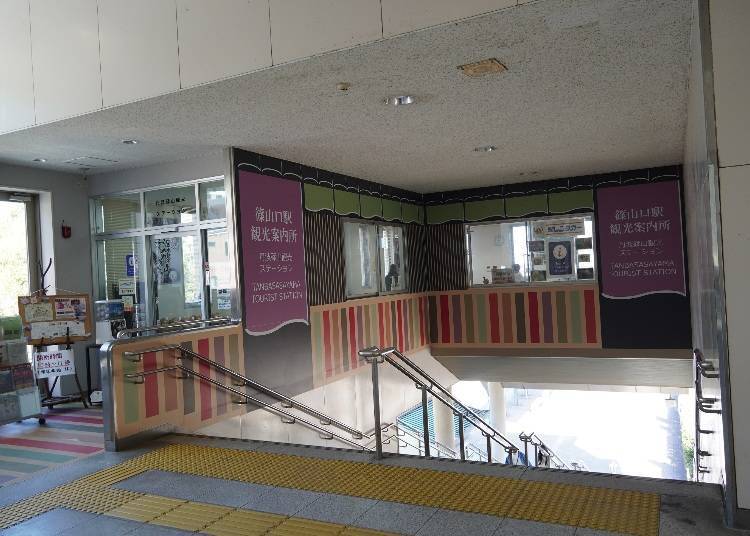
・Hours: 10:00 a.m. - 5:00 p.m.
・Closed: N/A
Exit the JR Shinoyamaguchi Station ticket gate and go down the passage to the left (West Exit). There you'll find coin lockers on the left and a tourist information center on the other end of the stairs.

Once inside, you’ll find a souvenir corner with Tamba-yaki pottery and sweets, which are specialties of the region. There’s also a tourist information counter and JR car rental desk at the back of the building, where English-speaking staff can help you.
Once you’ve obtained all the necessary information for your trip, hop aboard the bus and head to the castle town! Travel time between the station and the castle town tourist information center is about 15 minutes.
2. Sasayama Tourist Information Center (Castle Town)
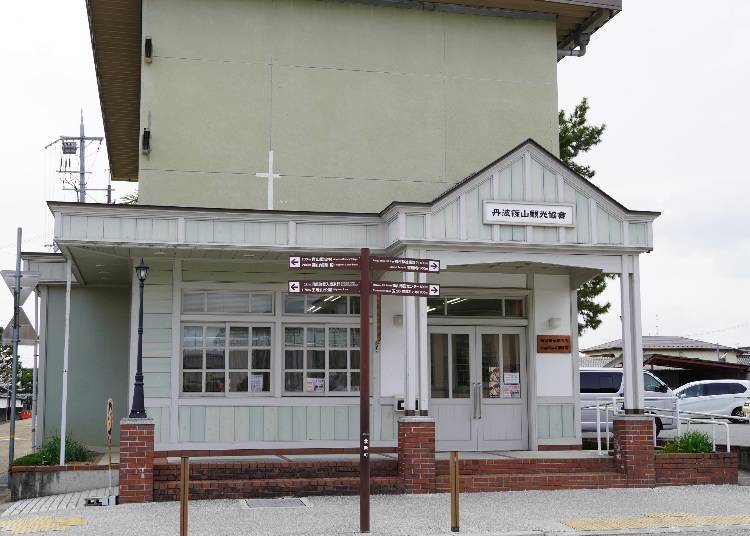
・Hours: 9:00 a.m. - 5:00 p.m.
・Closed: Year-end and New Year holidays
Near Sasayama Castle, on the west side of the Taisho-Roman Museum, is a tourist information center, although there is no foreign language-speaking staff inside. From there, it’s a short 5-minute walk to Sasayama Castle. To get to this tourist information center, take the Wing Shinki bus bound for Sasayama Office from Sasayamaguchi Station, and get off at Nikaicho. It’s a 1-minute walk south from there.
3. Taisho Roman Hall
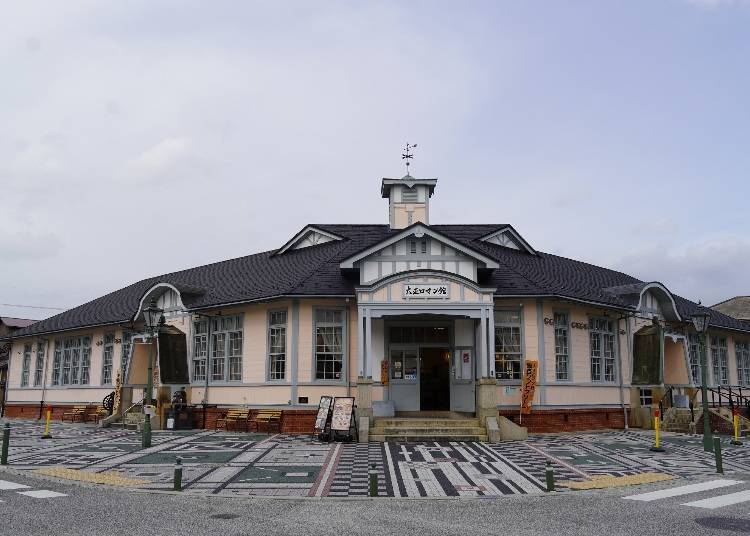
・Hours: 10:00 a.m. - 5:00 p.m.
・Closed: Tuesdays
The Taisho Roman Hall, formerly the Sasayama Town Hall, was built in the Taisho Era (1912-1926). Today, it has been repurposed as a tourist facility, with souvenir corners and restaurants inside and benches in the courtyard. It serves as a convenient stop for both shopping and bathroom breaks.
To get here, take the Wing Shinki bus bound for Sasayama Office from Sasayamaguchi Station to Nikaicho and head south for about one minute.
11 Things to do in Tamba-Sasayama
1. Sasayama Castle Oshoin: Castle town landmark (and today's starting point)
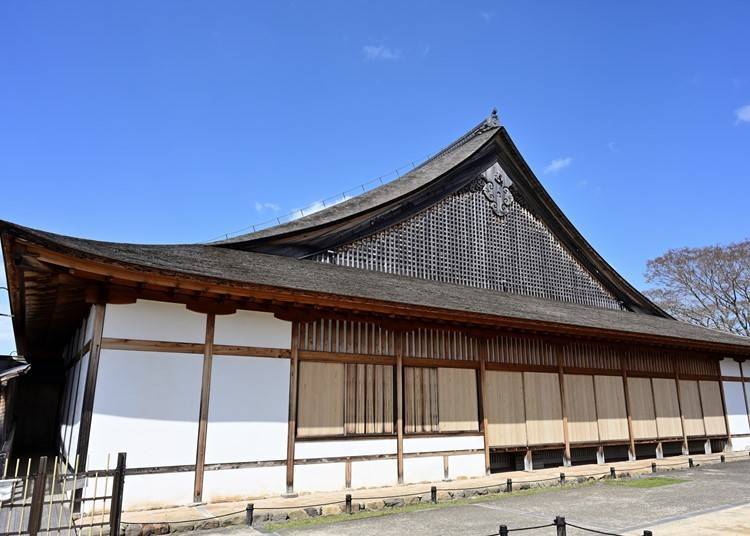
Located about a five-minute walk south of the Tourist Information Center and Taisho Roman Hall, Sasayama Castle Oshoin was built in 1609 concurrently with Sasayama Castle, for use during official events. Its use continued even after Sasayama Castle was decommissioned due to the Meiji Restoration (1868-1912) until it burned down in a fire in the early Showa Period (1926-1989).
The year 2000 saw the restoration of the building, which now houses a model of Sasayama Castle and other historical displays and exhibits, including videos about the castle’s construction.
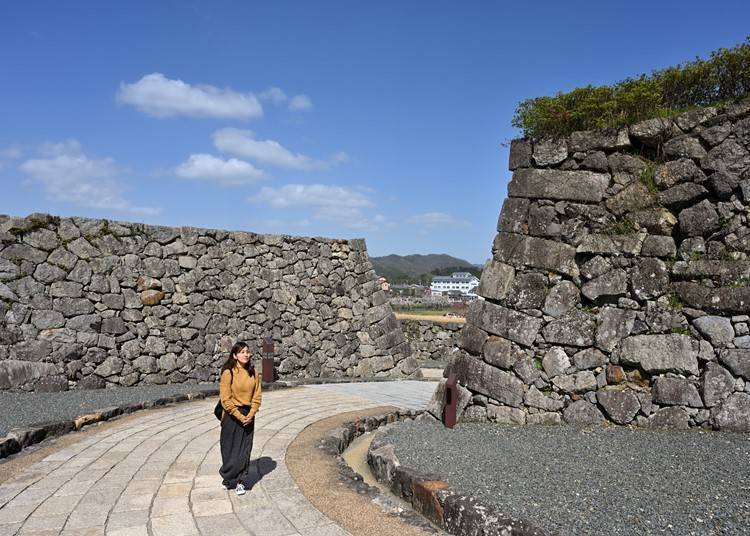
The outer moat, stone walls, and other remnants of the castle remain as they were back in the day. Once you pass through the stonewalls into the castle, you will find Ninomaru, Honmaru, and the castle tower, all open to the public free of charge. It also offers a panoramic view of the city of Tamba-Sasayama.
-
Sasayama Castle Ruins and the Oshoin篠山城 大書院
- Address 2-3 Kitashinmachi, Tambasasayama-shi, Hyogo 669-2332
-
Nearest Station
Access: Take Wing Shinki bus bound for Sasayama Office from Sasayamaguchi Station, ride to Nikaimachi, and head south for about five minutes.
- Phone Number 079-552-4500
・Hours: 9:00 a.m. - 5:00 p.m. (Last admission: 4:30 p.m.)
・Admission: Adults, 400 yen / High school & university students, 200 yen / Elementary & junior high students, 100 yen.
・Combined Admission (includes 4 museums): Adults, 600 yen / High school & university students, 300 yen / Elementary & junior high students, 150 yen.
Combined admission includes Museum of History, Anma-Family Samurai Residence Museum, Aoyama History Village, and Sasayama Castle Oshoin. Prices may vary during Museum of History special exhibitions.
・Closed: Mondays (open on national holidays, closed the following day) / year-end and New Year holidays (December 25 - January 1)
2. Kawaramachi Tsumairi Merchant Housing District: Stroll in time through traditional Japanese houses
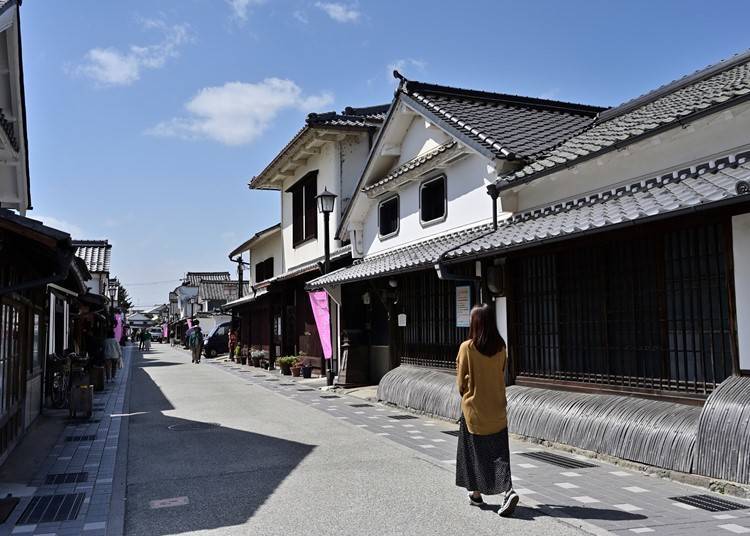
Kawaramachi Tsumairi Merchant Housing District, located about a 15-minute walk southeast of Sasayama Castle Oshoin, was originally established as a castle town at the time of Sasayama Castle’s construction, and has since been designated as an Important Preservation District for Groups of Traditional Buildings.
While each house has a narrow entrance of only 5 to 8 meters, its depth is over 40 meters long. This long and narrow style of architecture is called “tsumairi,” in which the buildings are arranged in rows along a 600-meter street from east to west.
The buildings’ interiors have since been renovated to operate for business and now serve as cafes, soba shops, restaurants, and all kinds of trendy shops. Simply stroll through the area and experience the essence of Japan’s Edo Period!
-
Kawaramachi Tsumairi Merchant Housing District河原町妻入商家群
- Address 177-1 Kawaramachi, Tamba-sasayama-shi, Hyogo 669-2325
-
Nearest Station
Access: Take Wing Shinki bus bound for Sasayama Office at Sasayamaguchi Station, and get off at Hon-Sasayama. Head east for about one minute.
3. Ojiyama Makekirai Inari: Enjoy a scenic walk through the red torii gates
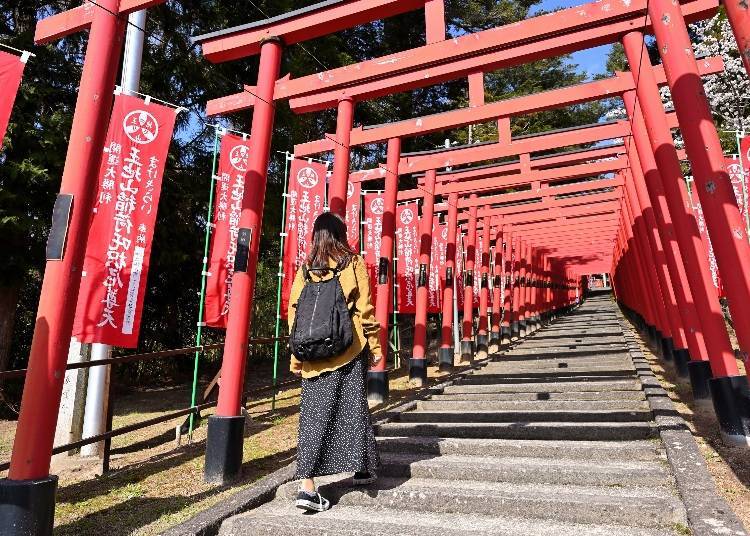
About 10 minutes northeast of Kawaramachi Tsumairi Merchant Housing District on foot is Ojiyama Makekirai Inari. More than 50 red torii gates stand in a row along a small hill, and they are a sight to behold. Take time as you walk up the gently sloping stone steps, stopping for photos along the way.
These 200-plus stone steps lead up to the torii gates, each bearing the name of the individual patron who has dedicated it to the shrine. Each step up the quiet approach allows visitors the chance to reflect as they ascend, where the only sounds are birdsong and trees rustling in the wind.

Visitors can pay their respects at the Hirayoshi Inari Shrine, located halfway up the stone steps, as they make their way up to Ojiyama Inari, also known as Makekirai Inari Shrine. The shrine is regarded as a power spot, attracting many visitors for its good fortune in business, success, and luck. It is also famous for cherry blossoms in spring and beautiful foliage in the fall.
-
Ojiyama Makekirai Inari shrine王地山まけきらい稲荷
- Address 92 Kawaramachi, Tamba-sasayama-shi, Hyogo 669-2325
-
Nearest Station
Access: Take Wing Shinki bus bound for Sasayama Office from Sasayamaguchi Station, ride to Kamitatemachi, and head east for about three minutes.
・Hours: Free to walk around
4. Tokusankan Sasayama: Taste local delicacies for lunch
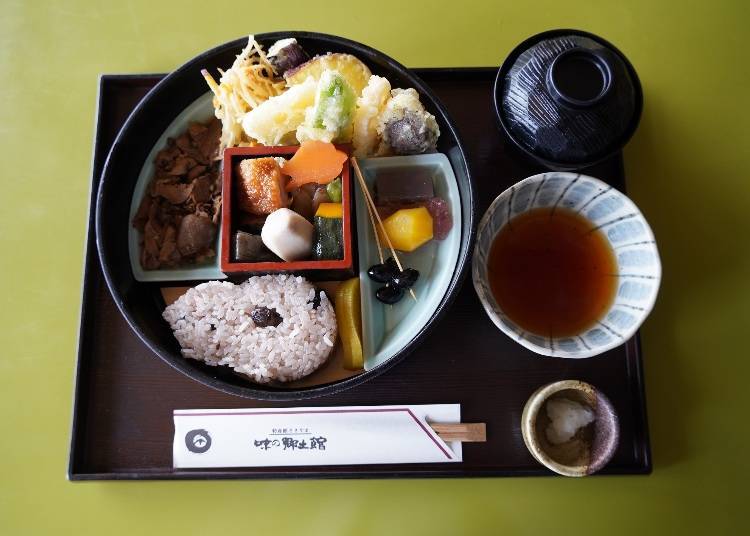
For lunch, treat yourself to Tokusan Sasayama’s “Mumon-sen Bento” (1,870 yen), packed with all sorts of local Tamba-Sasayama ingredients. The star of this bento is the seasonal vegetables. It includes Tamba-Sasayama beef seasoned with sweet and spicy shigureni, a variety of grilled seasonal vegetables, chicken teriyaki, and seasonal vegetable tempura. Depending on the season, you’ll also enjoy a rice bowl with black soybean, bamboo shoots, or chestnuts.
The dish also includes boiled Tamba black soybeans, sweetened chestnuts, and Dainagon azuki kanten (agar agar) for sweetness. Soup is also served on the side. The Mumon-sen is the family crest of the Aoyama clan, who were the lords of Sasayama Castle. The bowls designed to resemble this crest are an original Tokusankan Sasayama creation.

The restaurant, directly managed by Japan Agricultural Cooperative (JA), uses only the finest carefully-selected ingredients. Another dish worth mentioning is the brand-name Tamba-Sasayama Grilled Beef Set Meal (1,680 yen). There’s also the original Tamba-Sasayama Beef Shigure Donburi (1,375 yen), made with Koshihikari rice and topped with a generous helping of shigureni and grated yam, boasting a zesty sansho pepper flavor.
You can also enjoy natural wild boar from November to March, served as a hot pot or donburi bowl. Take-out is also available for those wishing to eat back at their accommodation or outdoors. Japanese and Western-style boxed lunches are also available for 1,600 yen each.

In addition to rice dishes, visitors can also treat themselves to sweets such as cakes and parfaits, as well as coffee, making it a convenient place for a pick-me-up. Menus include pictures, allowing customers to order with ease. In the annexed building, you’ll find a souvenir shop, and there’s also a huge parking lot that also accommodates sightseeing buses. Tokusankan Sasayama is a 16-minute walk northwest of Ojiyama Makekirai Inari.
-
Tokusankan Sasayama特産館 ささやま
- Address 70-1 Kurooka, Tamba-sasayama-shi, Hyogo 669-2321
-
Nearest Station
Access: Take Wing Shinki bus bound for Sasayama Office from Sasayamaguchi Station, ride to Kasuga Jinja-mae, and head northeast for about three minutes.
- Phone Number 079-552-3386
・Hours: 10:00 a.m. - 5:00 p.m. (Meals start at 11:00 a.m.)
・Closed: Wednesdays
5. Tamba-Sasayama City History and Art Museum: Admire armor, artifacts, and arts in a historic building
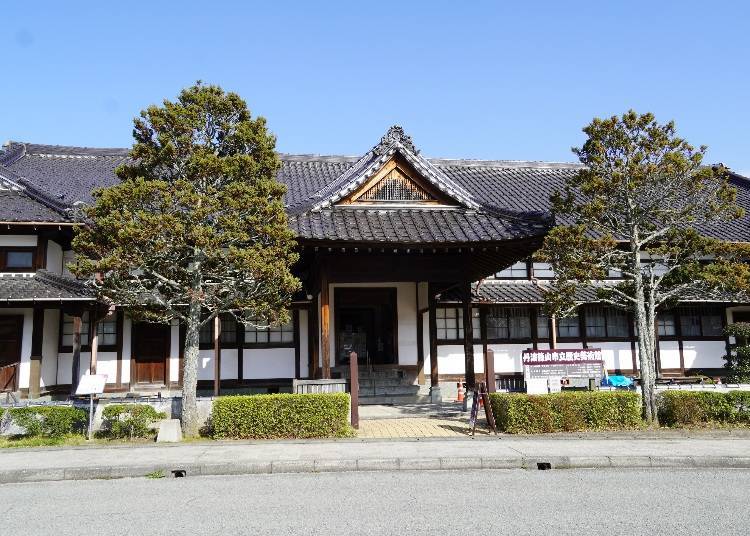
The Tamba-Sasayama City History and Art Museum is just a short walk south of Tokusankan Sasayama. Established in 1891, it served as a courthouse until 1981, when it was converted into an art museum, retaining its exterior and courtroom.
As one of the oldest wooden courthouses in Japan, it has been designated as an Important Cultural Property, with an interior design that is both simple and dignified. In the exhibition room, visitors can appreciate cultural artifacts that were excavated from the ruins, as well as armor, swords, and other historical relics related to Sasayama.
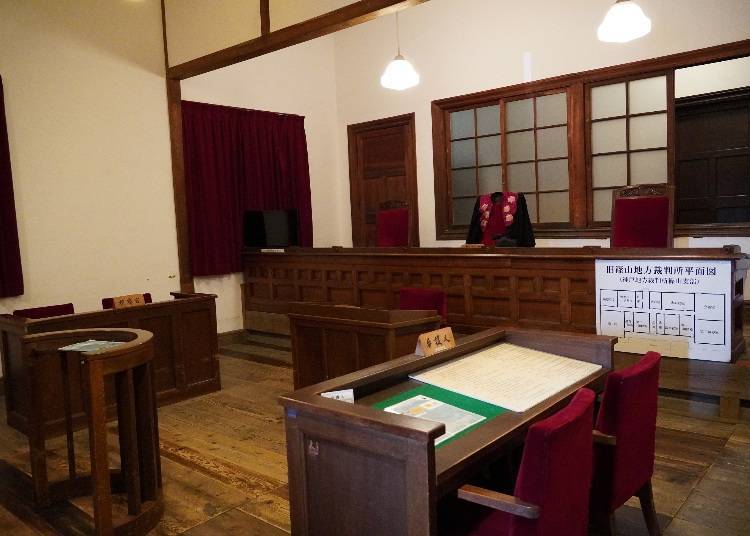
The main chamber retains its original courtroom appearance from the past, complete with the judge's seat, the prosecutor's seat a step down on either side, the defense counsel's seat, the witness stand in the center, and the hearing seats in the rear. Adorn yourself with a Meiji-era judge's uniform and hat, and sit in the judge's chair for a photo!
-
Tambasasayama Historical Art Museum丹波篠山市立歴史美術館
- Address 53 Gofukumachi, Tamba-sasayama-shi, Hyogo 669-2322
-
Nearest Station
Access: Take Wing Shinki bus bound for Sasayama Office from Sasayamaguchi Station to Kasuga Jinja-mae, and head east for about one minute.
- Phone Number 079-552-0601
・Hours: 9:00 a.m. - 5:00 p.m. (Last admission: 4:30 p.m.)
・Closed: Mondays (open on national holidays, closed the following day), year-end and New Year holidays (December 25 - January 1)
・Admission: Adults, 300 yen / High school & university students, 200 yen / Elementary & junior high students, 100 yen
・Combined Admission (includes 4 museums): Adults, 600 yen / High school & university students, 300 yen / Elementary & junior high students, 150 yen
Combined admission includes Museum of History, Anma-Family Samurai Residence Museum, Aoyama History Village, and Sasayama Castle Oshoin. Prices may vary during Museum of History special exhibitions.
6. Homei-shuzo Sake Brewery Horoyoi Jokagura: Sample sake at a historic brewery
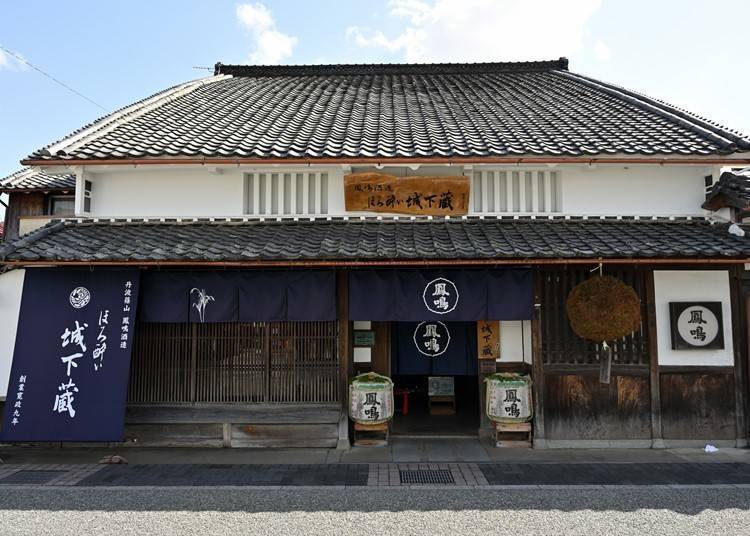
Homei-Shuzo is a long-established sake brewery, founded in 1797. Visitors can purchase sake from the shop, or visit the attached Horoyoi Jokagura, a former sake cellar that has been converted into an exhibition space.

Visitors can take a free tour of Horoyoi Jyokagura, which served as a brewery until 1975. Here you‘ll find tools formerly used in the sake brewing process, the rice washhouse, and the koji mold chamber. It’s an excellent opportunity to learn about the history and culture of sake brewing, with staff who will happily explain to visitors curious to learn more!
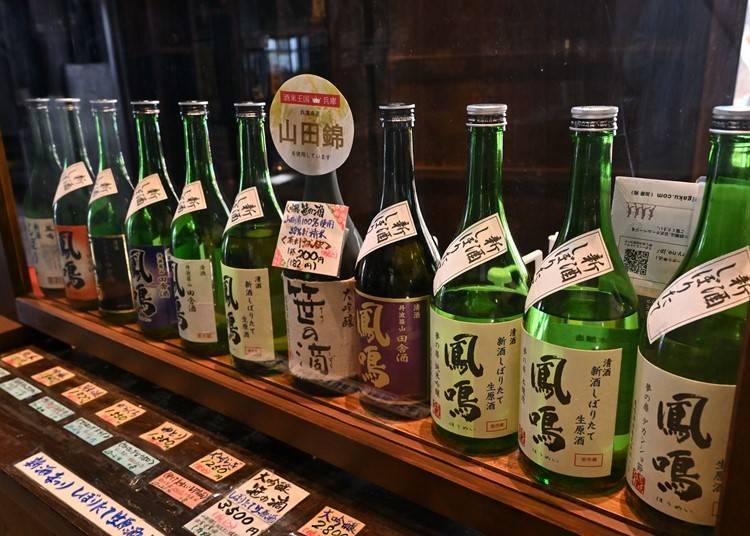
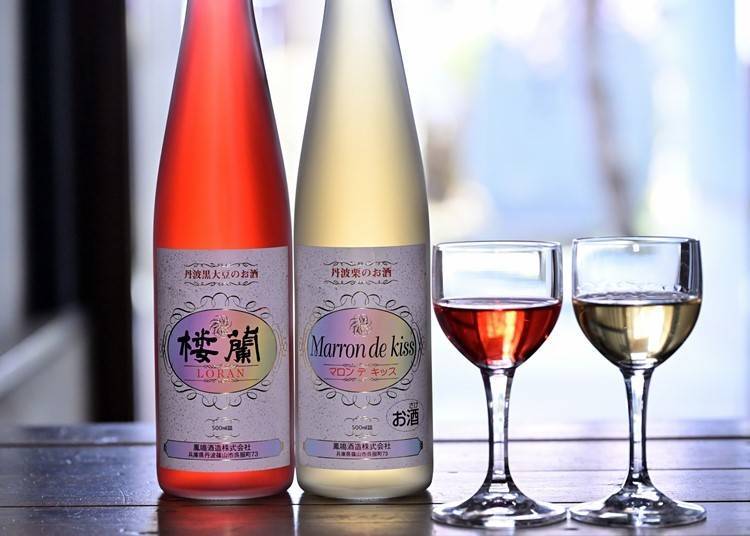
Visitors can sample and buy just about every type of sake available in the store. In addition to Yumenotobira, a sake in which music is played during the brewing process, and Sasanoshizuku, a Daiginjo sake made from Hyogo Prefecture's Yamada Nishiki sake rice, there are also a variety of other types of sake, including Loran, a liqueur made from Tamba black beans, and Marron de Kiss, a Tamba chestnut sake.
Please note that samples will not be served to those traveling by rental bicycle or other means.
Paid tastings with snacks are also available, starting at 418 yen.
・Sasanoshizuku (720ml): 3,300 yen & up
・Yumenotobira (300ml): 480 yen & up
・Loran / Marron de Kiss (500ml each): 1,200 yen
*All prices include tax.
Homei Sake Brewery Horoyoi Jokagura is about a one-minute walk eastward from the Tamba-Sasayama City History and Art Museum.
-
Homei-shuzo Horoyoi-jokagura鳳鳴酒造 ほろ酔い城下蔵
- Address 46 Gofukumachi, Tamba-sasayama-shi, Hyogo 669-2322
-
Nearest Station
Access: Take Wing Shinki bus bound for Sasayama Office from Sasayamaguchi Station to Nikaimachi; head east for about five minutes.
- Phone Number 079-552-6338
・Hours: 9:30 a.m. - 5:00 p.m.
・Closed: Tuesdays, Year-end and New Year holidays
7. Anma-Family Samurai Residence Museum: Relax with a matcha green tea experience
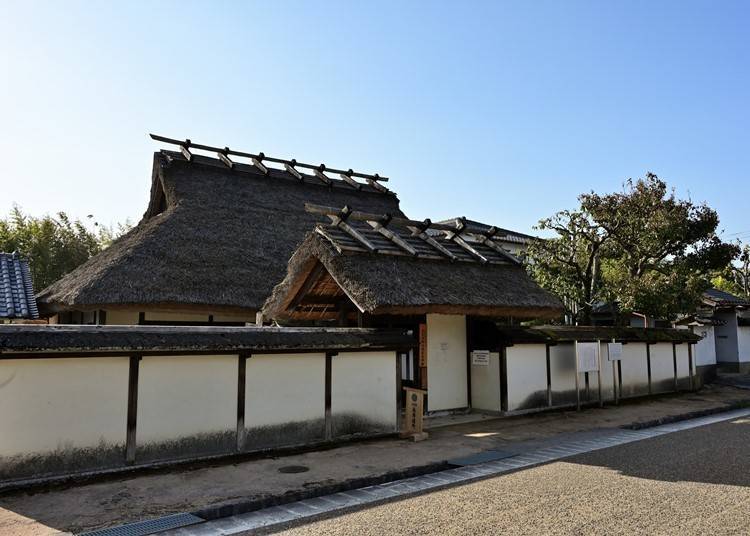
The town planning of the castle town commenced in 1609, one year after the construction of Sasayama Castle. The current Anma House was a samurai residence originally constructed after the great fire of 1830, and a typical residence of the time. The thatched main dwelling and tiled storehouse have been preserved, earning it its popularity and the nickname "Samurai House" among foreign visitors.
Inside the house, old documents, tableware, furniture, weapons, and other historical materials belonging to the Anma family are on display, offering a glimpse into the life of a real samurai family from the Edo Period.
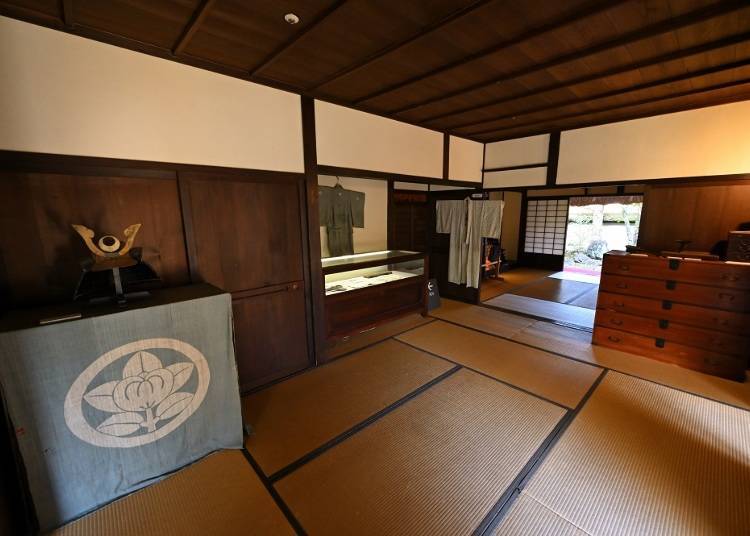

In the courtyard is a corner known as Tamba Suikinkutsu. The suikinkutsu was devised in the Edo Period (1603-1868), and features a mechanism in which a jar is placed into a cavity in the earth. As the water drips down, it produces the soothing sound of pure water trickling into the jar.
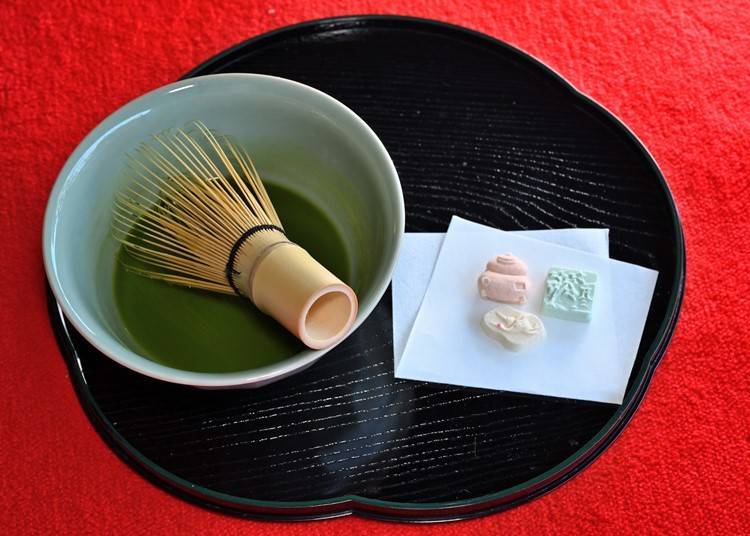
A Matcha Tea Experience is also available on the veranda (Plum Course: 400 yen, including dry confections; Bamboo Course: 700 yen, including fresh sweets; reservations required for Bamboo Course). Photo shows Ume Course.

For those unfamiliar with how to prepare the matcha, don't hesitate to ask the staff for help. First, place a sweet snack in your mouth, then follow that with a taste of matcha. This ensures an even richer matcha experience thanks to the subtle sweetness lingering on your tongue.
Located about 10 minutes southwest from Tamba-Sasayama City History and Art Museum by bicycle (15-20 min on foot).
-
Anmma Samurai House Museum武家屋敷安間家史料館
- Address 95 Nishishinmachi, Tamba-sasayama-shi, Hyogo 669-2334
-
Nearest Station
Access: Take Wing Shinki bus bound for Sasayama Office from JR Sasayamaguchi Station to Nikaimachi. From there, it’s a 15-min walk.
- Phone Number 079-552-6933
・Hours: 9:00 a.m. - 5:00 p.m. (Last admission 4:30 p.m.)
・Closed: Mondays (open if national holiday, and closed the following day), Year-end and New Year holidays (12/25-1/1)
・Admission: Adults, 200 yen / University & high school students, 100 yen / Junior high & elementary students, 50 yen
・4 Museums Combined Ticket: Adults, 600 yen / University & high school students, 300 yen / Junior high & elementary students, 150 yen
Combined admission includes Museum of History, Anma-Family Samurai Residence Museum, Aoyama History Village, and Sasayama Castle Oshoin. Prices may vary during Museum of History special exhibitions.
8. Baikakudo: Sample Japanese souvenir sweets featuring black soybeans
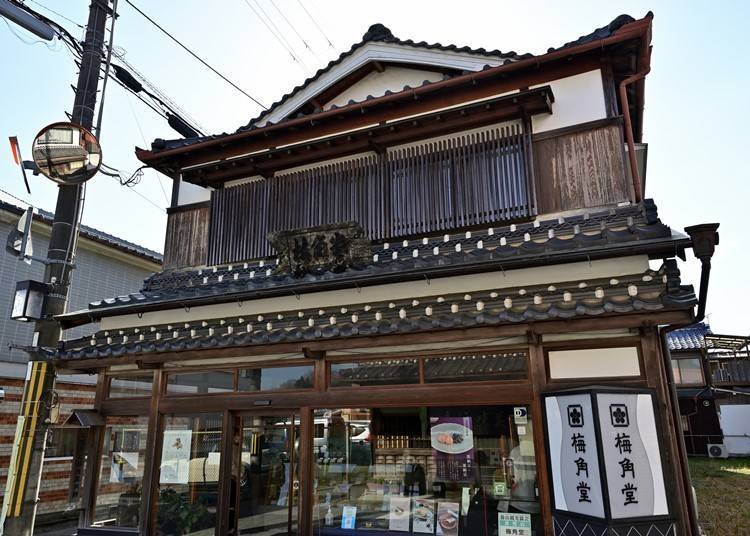
Baikakudo is a traditional Japanese wagashi shop established in 1909. This store is beloved by tourists and locals alike. It is especially popular for its Japanese confections, most of which are made from black Tamba-Sasayama soybeans and carefully crafted using only the finest ingredients and techniques.
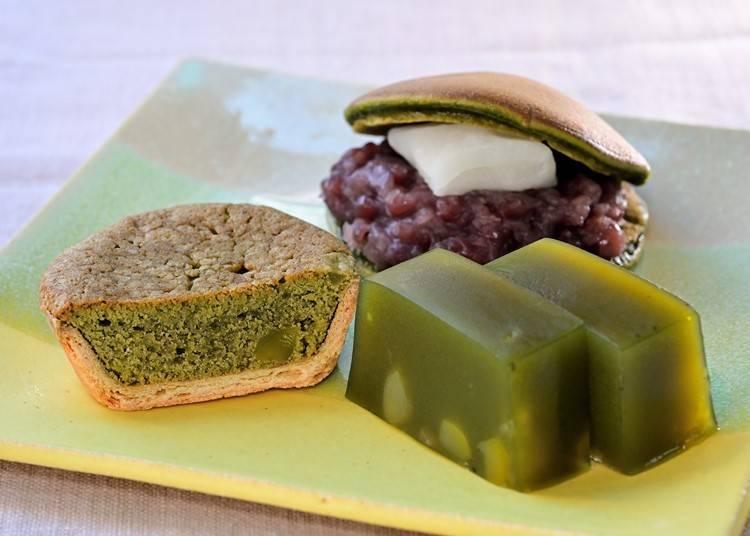
These sweets are prepared by a fourth-generation chef who was trained at a famous Kintsuba store. The Dorayaki (from 270 yen), a treat sandwiched between chunky dough, and the Chestnut Yokan, filled with azuki bean paste and chestnuts, are just two example of the delicious Japanese confections this spot has to offer!
The photo shows the Matcha series, which is popular among foreign tourists. The Matcha Dorayaki (270 yen, pictured above) is only available around late April through June, coinciding with the season for freshly harvested green tea. It consists of matcha dough with red bean paste and gyuhi (a type of mochi) sandwiched in between. The Matcha Chestnut Yokan Sasa-no-Tsuyu (700 yen and up) is sold all year round. This yokan is made with white bean paste instead of azuki red bean paste for a refreshing treat. The Sasayama Tart Green Tea and Chestnut (270 yen) is a deliciously bittersweet combination of green tea dough and chestnuts.

The Sasayama Tart tastes like a Western-style confectionery, with a light, pie-like crust, madeleine-like dough, and plenty of almond pudding. The Plain type includes either black beans or chestnuts, and each is available with an additional green tea or kintsuba (270 yen and up).
New seasonal and limited-time products are also available, so there is always something new to discover! These products also have a long shelf life and are sold by the box, making them the perfect souvenir choice.
Baikakudo is about six minutes on foot southwest of Homei Sake Brewery.
*All prices include tax.
-
Baikakudo梅角堂
- Address 78-1 Tatsumachi, Tamba-sasayama-shi, Hyogo 669-2323
-
Nearest Station
Access: From JR Sasayamaguchi Station, take Wing Shinki bus bound for Sasayama Office to Kamitate-machi; head north for about one minute.
- Phone Number 079-552-1311
・Hours: 10:00 a.m. - 6:00 p.m.
・Closed: Thursday (open if national holiday)
9. Odagaki Shoten / Odagaki Mamedo: Relax at a historic cafe
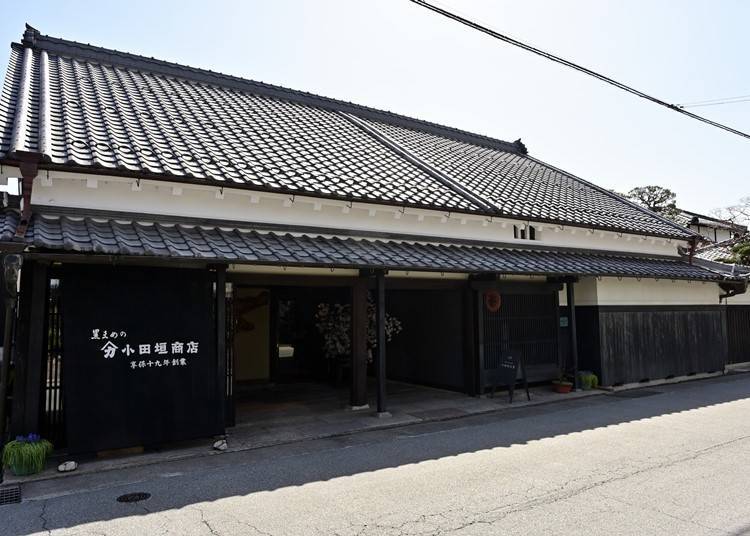
Founded in 1734, Odagaki Shoten was converted to a bean and seedling shop in 1868 and has operated as a wholesaler and retailer of beans ever since. The site is home to 10 National Tangible Cultural Properties, including buildings and warehouses built in the Edo Period. A portion of one of these buildings was renovated, opening as a cafe, Odagaki Mamedo, in April 2021.
The star of this cafe’s menu is its selection of kuromame dishes, including Tamba kuromame tea, sweets, and various other local delicacies. Menus are also available in English.
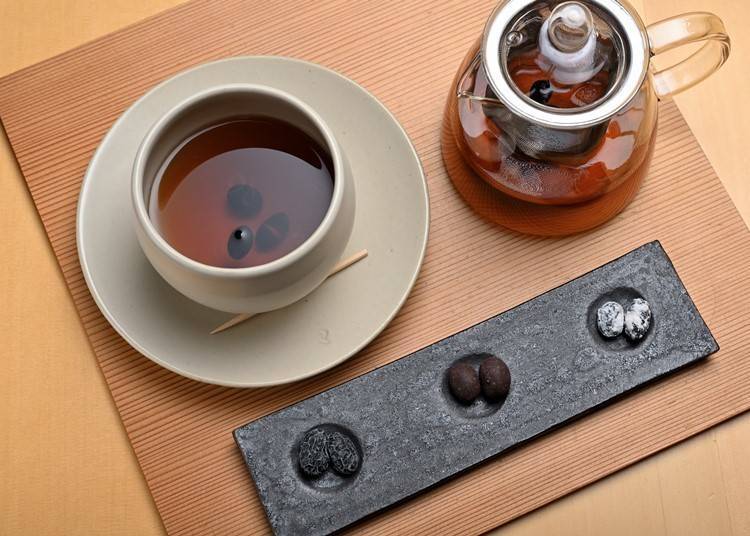
Odagaki Kuromame-cha (Kuromame Tea with 3 Types of Kuromame Sweets, 700 yen) is a tea made from large black soybeans produced in Tamba-Sasayama and roasted in-house. It’s one of the shop’s most popular items, offering a rich aroma in every sip.
Customers can enjoy their tea hot or iced, both of which include lightly roasted black soybeans at the bottom of the cup. A toothpick is provided with each cup that you can use to eat them. The simple taste of chunky steamed kuromame is a delightfully relaxing experience in a cup!
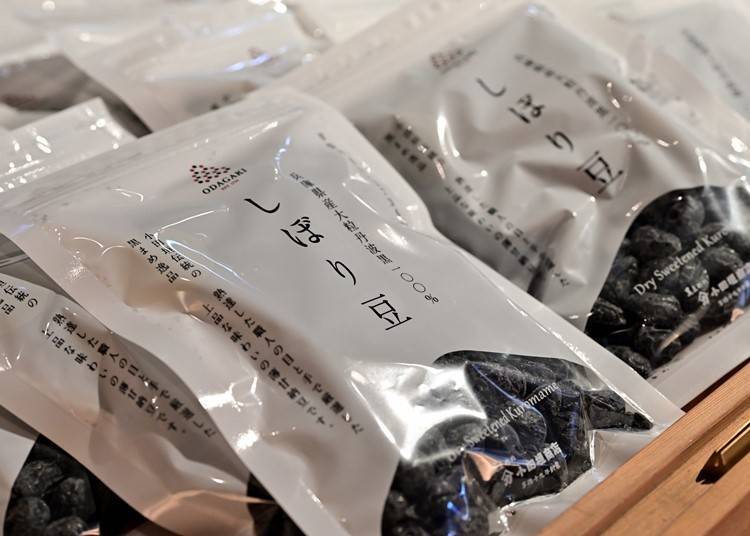
The set version of the ‘3 Types of Kuromame Sweets’ dish varies daily. On the day of our visit, the featured sweets were Shiborimame (sweet red beans), Bitter Chocolat (roasted kuromame coated with bitter chocolate), and Shukuru (roasted kuromame coated with sugar).
In addition to the sweets served in the set, the adjacent store sells snacks and processed goods made from azuki and kuromame beans. Many of these products are hard to find anywhere else, so it’s no wonder many visitors buy them in bulk for home use or as souvenirs.
Odagaki Shoten is about a 3-minute walk south of Baikakudo.
*All prices include tax.
-
Odagaki Shoten Main Store / Odagaki Mamedo小田垣商店本店/小田垣豆堂
- Address 19 Tatsumachi, Tamba-sasayama, Hyogo 669-2323
-
Nearest Station
Access: Take Wing Shinki bus bound for Sasayama Office from JR Sasayamaguchi Station to Kamitatemachi; walk two minutes south
- Phone Number 079-552-0011
・Hours: Cafe Odagaki Mamedo 11:00 a.m. - 5:00 p.m. (Last order at 4:00 p.m.) / Main store: 9:30 a.m.-5:30 p.m.
・Closed:
Cafe Odagaki Mamedo: Thursdays (Following weekday if national holiday), Year-end and New Year holidays
Main Store: Year-end and New Year holidays only
10. Katsugyo-kappo Hougyoen: Enjoy local cuisine for a delicious dinner
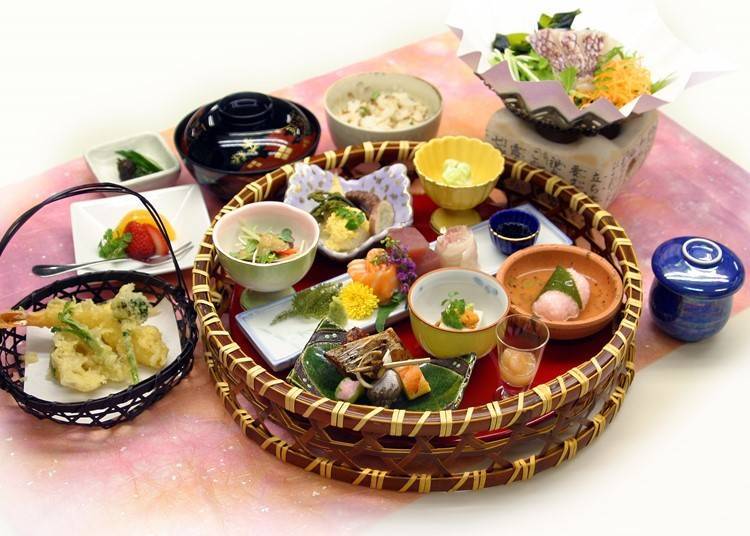
Katsugyo-kappo Hougyoen has been in business for 50 years and is known as one of the best Japanese restaurants in Tamba-Sasayama. One popular dish is the Basket Kaiseki, which features seasonal delicacies arranged in small bowls and colorfully presented in a basket. This sumptuous dinner, which also includes steamed egg custard, tempura, rice, red miso soup, and dessert, must be reserved at least one day in advance.
It’s a Japanese specialty restaurant where fresh local vegetables and fish delivered each morning from the central market are expertly prepared by experienced culinary chefs.
*The Yuki Course includes a small pot or ceramic plate with flowers.
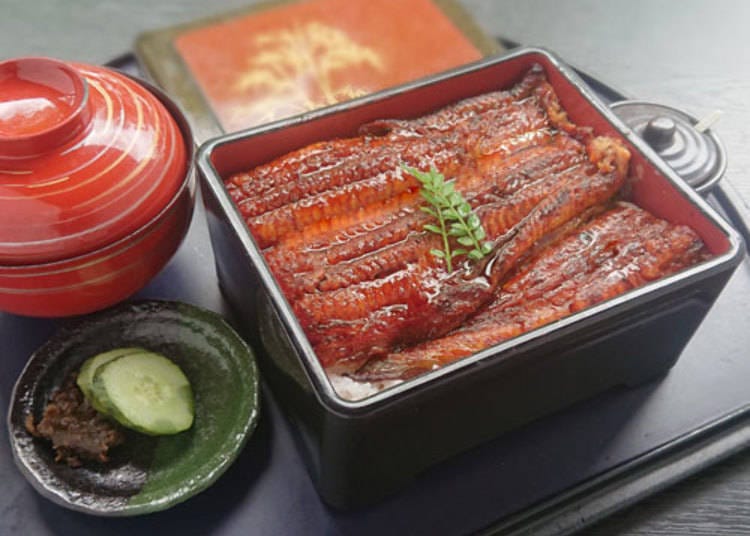
The Unaju (eel bowl) is a popular dish all year round, made with an entire fatty domestic eel, cleaned, cooked, and grilled over charcoal to aromatic perfection. The sweet aroma of the homemade sauce stirs the appetite, allowing customers to devour the dish in no time flat. Eels are sourced mainly from Kagoshima Prefecture, and although subject to change depending on availability, this shop is committed to using domestically sourced eels.

The restaurant is Japanese-style, and all rooms are private. Chairs and sunken kotatsu seats allow you to stretch your legs and enjoy your meal in comfort. There are no English menus, but the pictures make ordering easy. Most dishes for both lunch and dinner are also available without reservation. Reservations may be required for select seasonal dishes. Katsugyo-kappo Hougyoen is about 10 minutes by cab from Odagaki Shoten.
-
Katsugyo-kappo Hougyoen活魚割烹 宝魚園
- Address 52 Kawagita Shinden, Tamba-sasayama-shi, Hyogo 669-2725
-
Nearest Station
Access: 10 min. drive from JR Shinoyamaguchi Station (parking lot available; 40 vehicle capacity)
- Phone Number 079-593-1341
・Hours:
Lunch: 11:30 a.m. - 2:00 p.m.
Dinner: 5:00 p.m. - 9:00 p.m.
・Closed: Tuesdays
11. Sasayama Castle Town Hotel NIPPONIA: Unique accommodations for a special overnight stay
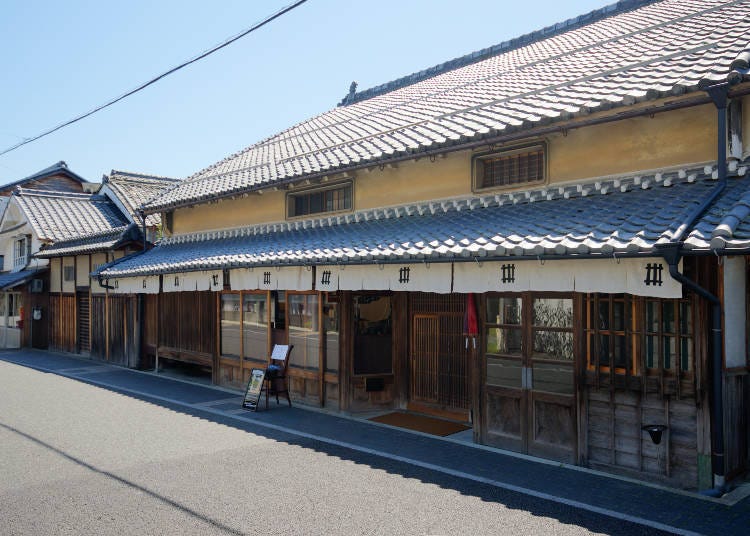
If you plan an overnight stay, here’s one spot you won’t want to overlook! This 400-year-old castle town has been transformed into a series of hotels, with eight historic private residences dotting the town under the concept of “an accommodation in a historic town in which you can feel at home.”
The design does not compromise the original ambiance of the homes and storehouses but provides a comfortable living space where you can relax and enjoy your stay.

Each of the eight guest rooms differs in interior design, evoking a sense of history that has been carefully preserved and passed down. This is not quite a hotel, nor a ryokan, nor a minshuku. It’s a unique lodging experience unlike anything you’ve ever encountered before!
-

-
Address
25 Nishimachi, Tanbasasayama-shi, Hyogo, 669-2342
View Map -
Nearest Station
Sasayamaguchi Station (JR Fukuchiyama Line / JR Takarazuka Line)
-
Address
25 Nishimachi, Tanbasasayama-shi, Hyogo, 669-2342
Tamba-Sasayama is a town rich in history and abundant in nature. While there are many long-established stores with centuries-old exteriors, there are also new shops that have been renovated from old residences. Just strolling around offers a variety of new and old discoveries, just waiting to be made. So, take a trip to Tamba-Sasayama, and explore these unique cultural attractions and beloved sights of the city.
*Information in article as of May 2023. Please see official websites for the latest updates and information.
English translation by: Krys Suzuki
Kiko Matsuda, Keiko Kimura, Risa Tsushi, and a team of female writers familiar with Kansai. We love eating, drinking and traveling! We share fun information based on our experiences.
*Prices and options mentioned are subject to change.
*Unless stated otherwise, all prices include tax.
Recommended places for you
-

ISHIDAYA Hanare
Yakiniku
Kobe, Sannomiya, Kitano
-
Goods

Yoshida Gennojo-Roho Kyoto Buddhist Altars
Gift Shops
Nijo Castle, Kyoto Imperial Palace
-

Jukuseiniku-to Namamottsuarera Nikubaru Italian Nikutaria Sannomiya
Izakaya
Kobe, Sannomiya, Kitano
-

Osaka Aquarium KAIYUKAN
Zoos, Aquariums & Botanical Gardens
USJ, Nanko Port
-

Kambei Sannomiyahonten
Yakiniku
Kobe, Sannomiya, Kitano
-

Kanzenkoshitsuyakinikutabehodai Gyugyu Paradise Sannomiya
Yakiniku
Kobe, Sannomiya, Kitano
-

Hyogo Prefecture Guide: Destinations, Activities, Travel Advice, Shopping & More
by: Kaori Kimura
-

Hotel Universal Port: A Fun-Filled Stay Where You Can Meet the Minions (In-Depth Review)
by: Tabiningen
-

Kyoto Prefecture Guide: Destinations, Activities, Travel Advice, Shopping & More
-

Where to See Fireworks in Osaka & Kansai (July–October 2025)
-

teamLab Announces New Permanent Kyoto Museum Opening in Fall 2025
-
Ad

Visiting the Osaka–Kansai Expo? Enjoy These 5 Great Itineraries from Osaka-umeda for Nature and City Lovers
Inspiration for Accommodations
-

Spacious Family Hotel in Namba: 20 Comfortable Stays for Family Fun
-

Charming Hotels to Enjoy the Spectacular Views of Arashiyama's Autumn Leaves from Your Room
-

Experience Stunning Views of Osaka Castle from Private Spaces: Top Hotels Near Osaka Castle
-

Recommended by Visitors! Arashiyama's Best-Rated Hotels
-

Family-Friendly Universal Studios Japan Hotel with Excellent Access
-

Enjoy a Comfortable Stay in Osaka! 10 Hotels with Convenient Airport Shuttle Services
-

Top 10 Recommended Hotels Near Namba Station with Great Access
-

Enjoy Night Views from Your Room! Recommended Hotels in Namba Area
-

Healthcare in Japan for Tourists: What to Do When You Get Sick or Injured in Japan
-

Enjoy Kobe’s Historic Charm: A 2-Hour Itinerary for Kitano-cho Ijinkan
-

Highlights of Umeda Sky Building: Get the Perfect Views of Osaka!
-

15 Attractions & Things To Do In Arashiyama For First-Time Visitors
by: WESTPLAN
-

Popular Food at Universal Studios Japan
by: WESTPLAN
-

Osaka's Central Public Hall: Inside the Incredible Iconic Tourist Attraction
- #best gourmet Osaka
- #things to do Osaka
- #what to do in kyoto
- #what to bring to japan
- #best gourmet Kyoto
- #new years in Osaka
- #what to buy in nanba
- #Visiting Osaka
- #onsen tattoo friendly arima
- #daiso
- #Visiting Kyoto
- #best japanese soft drinks
- #japanese fashion culture
- #japanese convenience store snacks
- #japanese nail trends













